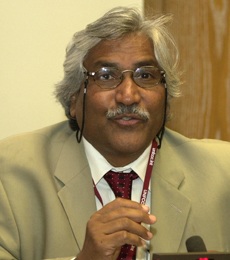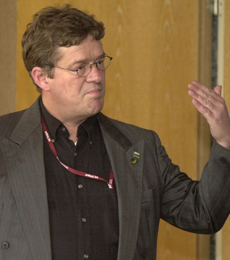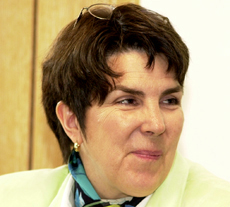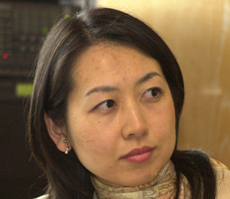 |
||
|
published by IISD, the International Institute for Sustainable Development
in cooperation with the Climate Change Secretariat. |
|||
|
Special Report on Selected Side Events at SB 22
|
|||||
| 19-27 May 2005 | Bonn, Germany | |||||
 |
||||||||||||||||
 |
||||||||||||||||
 |
||||||||||||||||
|
||||||||||||||||
|
Events convened on Saturday, 21 May 2005 |
||||||||||||||||
|
|||
|
|||
|
||||||||||||||||||||||||||||||
|
|||
|
Implementing the Global Ocean Observing System for Climate Presented by the World Meteorological Organization |
||||||
 |
Keith Alverson, Global Ocean Observation System (GOOS), highlighted gaps in the GOOS including: implementing the remainder of the observation system; developing technology for observing the polar regions; involving developing countries; researching coastal zones, and the chemistry and biology of oceans; and integrating ocean observation data.
Paul Mason, Global Climate Observation System (GCOS), underscored the impact of oceans on climate variability and outlined ongoing issues in the ocean component of the GCOS, including: the organization of ocean observation at national and international levels; inadequate coverage of the ocean system; insufficient subsurface observations; and the high dependence of ocean observation on research. Edward Harrison, Ocean Observations Panel for Climate, emphasized that additional knowledge is needed on how oceans affect climate variability and that the core challenge is sustaining global ocean observation. He called on countries to: enhance global and regional cooperation; ensure open data exchange; make use of modern technology; and match resources to necessary activities. Harrison also discussed: ocean variability; the effects of El Niño; the oceans’ estimated anthropogenic carbon uptake; sea ice and sea levels; and catastrophic oceanic changes. Albert Fischer, GOOS, outlined the Implementation Plan for the GCOS, noting that half its goals have been completed but that full completion by 2010 will require additional investment and improved planning and coordination. He also discussed the use of Argo profiling floats and sea level stations in ocean observation, the role of the research community in ocean observation, and the continuity of satellite observations. Discussion: Participants discussed the Global Earth Observing System, ice sheet disintegration, the GCOS Implementation Plan, coordination with natural hazard warning systems, ocean acidification, and the coastal module of GOOS. |
|||||
| Keith Alverson, GOOS, said we have a well-planned ocean observation system but that gaps remain in its implementation | ||||||
|
|||
|
Toolkits for adaptation to climate change Presented by the World Bank |
|||||
 |
Thomas Downing, Stockholm Environment Institute (SEI), considered different methodologies employed in choosing adaptation tools. He stressed that in identifying the goals, “analytical teams” and vulnerabilities are essential at the screening stage. He emphasized that methods should be coherent at the local and national levels and link over time.
Atiq Rahman, Bangladesh Centre for Advanced Studies, focused on integrating institutional and policy issues into adaptation tools. He indicated that difficulties may arise when choosing experts, accounting for national plans, and integrating poverty reduction strategies. He emphasized the importance of linking sectors, institutions and stakeholders at all levels, and the need to consider how policies are developed and how implementation takes place. Jo-Ellen Parry, IISD, presented the livelihoods and climate change adaptation tool developed by IISD, SEI, World Conservation Union (IUCN), and Intercooperation. She said the rationale of the tool is for community-level projects to improve adaptive capacities. She explained that in creating the tool, the developers drew on, inter alia, environmental impact assessment models and individual project activities. Ian Noble, World Bank, demonstrated a World Bank screening and design tool for considering adaptation to climate change. He said the World Bank developed the tool to be used by project developers and assessors, and NGOs, but not by decision-makers at the community level. He indicated that the purpose of the tool is to provide a preliminary check of issues that might arise during project design or implementation. He highlighted that the tool will be open-ended so that it can adapt to specific projects. Discussion: Participants raised specific questions on: the tools demonstrated; how to bring the human factor into the models; and whether the tools were too complicated for use at the local level. |
||||
| Atiq Rahman, Bangladesh Centre for Advanced Studies, said that the best method for adaptation is mitigation | |||||
|
|||
|
The ultimate objective of the UNFCCC: An ethical argument Presented by Germany |
|||||
 |
Highlighting the necessity of value judgements, Konrad Ott, Ernst-Moritz-Arndt University, said cost-benefit analysis should not be a decisive criterion for climate policy. He highlighted that most ethical theories support low or very low carbon stabilization levels and suggested 450 parts per million (ppm) as an ethically justified target. He noted that most theories of distributive justice favor equality and that ethical argumentation supports the “contraction and convergence” approach to emission allowances.
Gernot Klepper, Kiel Institute for World Economics, explored the three constraints listed in Article 2 of the UNFCCC, namely ecosystem adaptation, food security, and sustainable economic growth. He discussed an evaluation matrix where the three constraints are interpreted in light of their regional scope, uncertainty, distributional effects and inter-temporal issues. He highlighted the need to make value judgments based on ethical principles for interpreting the three constraints and their trade-offs. In outlining the German Advisory Council’s views on climate policy, Patrick Matschoss, German Advisory Council on the Environment, noted the 2C global warming target and proposed that the global carbon concentration target should be 450 ppm. He underscored that industrialized countries must reduce emissions more than the world average. Indicating that about half of Germany’s energy generation capacity must be replaced by 2030, he noted that new eco-technologies are essential to achieve the UNFCCC’s objective. Discussion: Participants discussed the impact of population growth, economic activities and the right to cultural identity on the 450 ppm stabilization goal. In discussing whether economic growth can be equated with sustainability Klepper said he does not believe that environmental constraints make economic growth impossible. |
||||
| Konrad Ott, Ernst-Moritz-Arndt University, said the battle over climate change is not over but just beginning | |||||
|
|||
|
||
|
Click the above button to go back to our ENB main coverage
|
||
|
|
|
|
|
||
|



